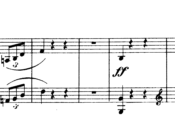Analysis
First Movement (Andante Con Espressione)
Form: Air with Variations. C Major.
THEME (Bars 1-10):
Theme. Tonic key, C Major, modulates to Dominant key, G Major (Bar 6), to end with Perfect Cadence (Bar 10).
Double Bar and Repeat.
VARIATION 1 (Bars 11-26):
Commences in Tonic minor key, C minor. Opening bars of Theme appears in Tonic minor and then transfers to Bass (14), with Supertonic Chromatic Seventh to return to C minor (Bar 17). Theme re-enters in C Major (Bar 18) with further Variation (Bars 20-22). The dotted quaver (eighth note) and semiquaver (sixteenth note) Figure brings the Variation to a close with Perfect Cadence.
Double Bar and Repeat.
VARIATION 2 (Bars 27-55):
Theme again enters in Tonic minor key, C minor, leading though G minor (Bar 32) to C minor (Bar 37). This Variation now introduces a flowing semiquaver (sixteenth note) Figure to extend it considerably as it moves to G minor (Bar 42), C minor (Bar 47), F minor (Bar 49), to end in G Major with Perfect Cadence.
Double Bar and no Repeat.
VARIATION 3 (Bars 56-72):
Theme opens in Tonic key, C Major, the Variation being made by Triplet Figure and demi-semiquaver (thirty-second note) passages to move to C Major (Bar 66) and end with Imperfect Cadence (Bar 72).
VARIATION 4 (Bars 73-97):
Single crochet Figure in R.H. accompanied by Broken Chord effect in semiquavers (sixteenth notes) in L.H. Key, C Major, moves to D minor (Bar 77), C Major (Bar 79), C minor (Bar 82), E flat Major (Bar 84), G minor (Bar 85), to C Major (Bar 89), then D minor (Bar 93) to end with Perfect Cadence in C Major.
Double Bar and no Repeat.
VARIATION 5 (Bars 98-120):
Crochet Figure accompanied by semiquaver (sixteenth note) Figure in Tonic minor key, C minor, moves from part to part, modulating through F minor, A flat Major, to lead to Opening Bars of Theme in tonic minor key, (Bar 109), touching B flat minor (Bar 114), returns to C minor (Bar 115), to end with Imperfect Cadence (Bar 120).
Double Bar and no Repeat.
VARIATION 6 (Bars 121-135):
Semiquaver (sixteenth) triplet Figure again coupled with single Crochet notes in Tonic key, C Major, forms this Variation into a Coda ending with Perfect Cadence.
Second Movement (Presto)
Form: Rondo Form. C Major.
Principle Theme. Tonic key, C Major. Ternary Form. (Bars 1-32):
Bars 1-13: A. C Major ends with Perfect Cadence in Dominant key, G Major. Double Bar and Repeat.
Bars 14-22: B. Commences in C Major, moving to F Major (Bar 19), to end with Imperfect Cadence in Tonic Key, C Major (Bar 22).
Bars 23-32: A. Return of Opening Theme in Tonic key, C Major, altered at Bar 28 to end with Perfect Cadence in Tonic key. Double Bar and Repeat.
EPISODE I (Bars 33-90):
Commences with Material of Theme in C Major, moves to G Major (Bar 38) with Fragments of Theme over the Dominant Pedal-point (D) at Bars 48-55. Material of Theme re-enters in Dominant key, G Major (Bar 57), leading to new material to end with Perfect Cadence (Bars 89-90). Bars 90-94 form a Link built upon Theme in Tonic Key, C Major.
Principle Theme. Tonic key, C Major. Ternary Form. (Bars 95-124):
Bars 95-107: A. Tonic key, C Major, ends with Perfect Cadence in Dominant key, G Major.
Bars 107-114: B. C Major through F Major (Bar 111), to Perfect Cadence in G Major (Bar 115).
Bars 115-124: A. Tonic key, C Major, touches G Major (Bar 120) to end with Perfect Cadence in C Major. Double Bar and no Repeat.
EPISODE II (Bars 125-175):
New Material in Tonic minor key, C minor, touches F minor (Bar 141), also B flat Major (Bar 144), returns to Tonic key, C Major (Bar 147), A flat Major (Bar 149), moving to C minor (Bar 154). References to material of Theme, passing through F minor (Bar 164) to C minor (Bar 168), ending with Chord of the Dominant Seventh of C. Double Bar and no Repeat.
Principle Theme. Tonic key, C Major. Ternary Form. (Bars 176-223):
Bars 176-188: A. C Major ends with Perfect Cadence in Dominant key, G Major. No Double Bar and Repeat.
Bars 188-196: B. Tonic key, C Major, to F Major (Bar 192), ends Perfect Cadence in Dominant, G Major (Bar 196).
Bars 196-223: A. This section is extended and varied in the style used so frequently by Haydn in many of the Sonatas, concluding with material of Episode II. Dominant Pedal-point at Bar 212.
Bars 224-226: Coda. Preceded by a short Link (Bars 220-223), it commences with material of Principle Theme in Tonic key and continues to introduce Material of Episodes with Material of Theme to end with Perfect Cadence in C Major.








